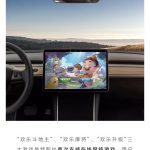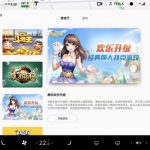

News
Tesla Arcade in China to get online multiplayer titles from Tencent
Tesla China plans to roll out three popular online games, a local weather app, an air quality alert system, and two streaming apps to its customers in the country in the first quarter of 2020. The official announcement as shared by Tesla owner-enthusiast Ray4Tesla on Twitter lists popular online titles Fight Landlords, Mahjong, and Happy Upgrade as part of the expected update. Tesla owners can play these games with their friends using their WeChat or QQ accounts.
These video games and apps are all products of Tencent Holdings, a Chinese multinational conglomerate with a market cap of about $461 billion that offers internet and mobile value-added services, advertising, and e-commerce transactions through its subsidiaries. In 2017, Tencent bought a 5% stake in Tesla, a strategic move that gave the electric car manufacturer a solid ally in China.
Fight Landlords, Mahjong, and Happy Upgrade are among the most popular Tencent Games played on QQ, an instant messaging app with more than 807 million users as of last year. Such games add color to the in-car entertainment system of Tesla that could provide a good boost to attract local, young, and tech-savvy car buyers in the country. Likewise, WeChat is also a property of Tencent and is the most popular messaging app in China with over a billion active users per month.
- Tesla China Multiplayer Video Games And Useful Apps (Source: Ray4Tesla | Twitter)
- Tesla China Multiplayer Video Games And Useful Apps (Source: Ray4Tesla | Twitter)
- Tesla China Multiplayer Video Games And Useful Apps (Source: Ray4Tesla | Twitter)
QQ and WeChat are prominent messaging and social media apps treasured by businesses in China where 91 percent of online users have social media accounts. Consumers use these platforms to communicate, research brands, play games, and engage in transactions. Tesla’s presence on these popular apps gives the company some leverage if it wants to crack the local market. This should give Tesla an edge against established brands such as BMW, GM, and Volkswagen, to name a new.
Video games are nothing new in Tesla cars as the electric car maker has practically turned its vehicles’ infotainment system into a gaming console that could be used while the cars are on Park. Tesla offers various games that appeal to a wide range of users such as classic Atari games, Chess, Beach Buggy Racing 2, and more recently, Cuphead.
As Tesla China prepares for its first deliveries of the Model 3, rolling out popular games and useful apps can also help the brand attract more buyers away from local competition. They can serve as talking points that can further strengthen word of mouth marketing that has saved Tesla millions in advertising costs too. Furthermore, such a move shows the local market that Tesla is fully-committed to provide owners in the country with the best user experience possible.
#Tesla 🇨🇳 officially announced 3 popular online games (“Fight Landlords”, “Mahjon”, “Happy Upgrade”) will be pushed to #Tesla owners in Q1, along w/ 2 streaming APPs, local weather plus air quality alert. Owners can log into their QQ or WeChat account to play remotely w/ others. pic.twitter.com/vrgRln21Wt
— Ray (@ray4tesla) December 20, 2019
This focus on its vehicles’ fun factor has been mentioned by CEO Elon Musk in the past. “The goal for the infotainment system is to say what’s the most amount of fun you can have in a car. I don’t think other car companies really think about it that way. It’s not just some sort of transport utility device with no soul and no character,” Musk said during the Q3 2019 earnings call.
Aside from the popular video games, the local weather app and air quality app come handy for consumers in China who live in areas with poor air quality.
As announced by the country’s Ministry of Industry and Information Technology earlier this month, two variants of the locally-made Tesla Model 3 will receive subsidies from the government. Deliveries of Made-in-China Model 3s also appear to be just around the corner, with car carriers filled with the vehicle being spotted in Gigafactory 3’s holding lots.
The announcement of Tesla China coincides with Elon Musk’s tweet about Tesla’s upcoming 2019 holiday software update, which is expected to include a “sneak preview” of Full-Self Driving, new games, and possibly a number of video streaming apps.

Elon Musk
Elon Musk and Tesla AI Director share insights after empty driver seat Robotaxi rides
The executives’ unoccupied tests hint at the rapid progress of Tesla’s unsupervised Robotaxi efforts.

Tesla CEO Elon Musk and AI Director Ashok Elluswamy celebrated Christmas Eve by sharing personal experiences with Robotaxi vehicles that had no safety monitor or occupant in the driver’s seat. Musk described the system’s “perfect driving” around Austin, while Elluswamy posted video from the back seat, calling it “an amazing experience.”
The executives’ unoccupied tests hint at the rapid progress of Tesla’s unsupervised Robotaxi efforts.
Elon and Ashok’s firsthand Robotaxi insights
Prior to Musk and the Tesla AI Director’s posts, sightings of unmanned Teslas navigating public roads were widely shared on social media. One such vehicle was spotted in Austin, Texas, which Elon Musk acknowleged by stating that “Testing is underway with no occupants in the car.”
Based on his Christmas Eve post, Musk seemed to have tested an unmanned Tesla himself. “A Tesla with no safety monitor in the car and me sitting in the passenger seat took me all around Austin on Sunday with perfect driving,” Musk wrote in his post.
Elluswamy responded with a 2-minute video showing himself in the rear of an unmanned Tesla. The video featured the vehicle’s empty front seats, as well as its smooth handling through real-world traffic. He captioned his video with the words, “It’s an amazing experience!”
Towards Unsupervised operations
During an xAI Hackathon earlier this month, Elon Musk mentioned that Tesla owed be removing Safety Monitors from its Robotaxis in Austin in just three weeks. “Unsupervised is pretty much solved at this point. So there will be Tesla Robotaxis operating in Austin with no one in them. Not even anyone in the passenger seat in about three weeks,” he said. Musk echoed similar estimates at the 2025 Annual Shareholder Meeting and the Q3 2025 earnings call.
Considering the insights that were posted Musk and Elluswamy, it does appear that Tesla is working hard towards operating its Robotaxis with no safety monitors. This is quite impressive considering that the service was launched just earlier this year.
Elon Musk
Starlink passes 9 million active customers just weeks after hitting 8 million
The milestone highlights the accelerating growth of Starlink, which has now been adding over 20,000 new users per day.

SpaceX’s Starlink satellite internet service has continued its rapid global expansion, surpassing 9 million active customers just weeks after crossing the 8 million mark.
The milestone highlights the accelerating growth of Starlink, which has now been adding over 20,000 new users per day.
9 million customers
In a post on X, SpaceX stated that Starlink now serves over 9 million active users across 155 countries, territories, and markets. The company reached 8 million customers in early November, meaning it added roughly 1 million subscribers in under seven weeks, or about 21,275 new users on average per day.
“Starlink is connecting more than 9M active customers with high-speed internet across 155 countries, territories, and many other markets,” Starlink wrote in a post on its official X account. SpaceX President Gwynne Shotwell also celebrated the milestone on X. “A huge thank you to all of our customers and congrats to the Starlink team for such an incredible product,” she wrote.
That growth rate reflects both rising demand for broadband in underserved regions and Starlink’s expanding satellite constellation, which now includes more than 9,000 low-Earth-orbit satellites designed to deliver high-speed, low-latency internet worldwide.
Starlink’s momentum
Starlink’s momentum has been building up. SpaceX reported 4.6 million Starlink customers in December 2024, followed by 7 million by August 2025, and 8 million customers in November. Independent data also suggests Starlink usage is rising sharply, with Cloudflare reporting that global web traffic from Starlink users more than doubled in 2025, as noted in an Insider report.
Starlink’s momentum is increasingly tied to SpaceX’s broader financial outlook. Elon Musk has said the satellite network is “by far” the company’s largest revenue driver, and reports suggest SpaceX may be positioning itself for an initial public offering as soon as next year, with valuations estimated as high as $1.5 trillion. Musk has also suggested in the past that Starlink could have its own IPO in the future.
News
NVIDIA Director of Robotics: Tesla FSD v14 is the first AI to pass the “Physical Turing Test”
After testing FSD v14, Fan stated that his experience with FSD felt magical at first, but it soon started to feel like a routine.

NVIDIA Director of Robotics Jim Fan has praised Tesla’s Full Self-Driving (Supervised) v14 as the first AI to pass what he described as a “Physical Turing Test.”
After testing FSD v14, Fan stated that his experience with FSD felt magical at first, but it soon started to feel like a routine. And just like smartphones today, removing it now would “actively hurt.”
Jim Fan’s hands-on FSD v14 impressions
Fan, a leading researcher in embodied AI who is currently solving Physical AI at NVIDIA and spearheading the company’s Project GR00T initiative, noted that he actually was late to the Tesla game. He was, however, one of the first to try out FSD v14.
“I was very late to own a Tesla but among the earliest to try out FSD v14. It’s perhaps the first time I experience an AI that passes the Physical Turing Test: after a long day at work, you press a button, lay back, and couldn’t tell if a neural net or a human drove you home,” Fan wrote in a post on X.
Fan added: “Despite knowing exactly how robot learning works, I still find it magical watching the steering wheel turn by itself. First it feels surreal, next it becomes routine. Then, like the smartphone, taking it away actively hurts. This is how humanity gets rewired and glued to god-like technologies.”
The Physical Turing Test
The original Turing Test was conceived by Alan Turing in 1950, and it was aimed at determining if a machine could exhibit behavior that is equivalent to or indistinguishable from a human. By focusing on text-based conversations, the original Turing Test set a high bar for natural language processing and machine learning.
This test has been passed by today’s large language models. However, the capability to converse in a humanlike manner is a completely different challenge from performing real-world problem-solving or physical interactions. Thus, Fan introduced the Physical Turing Test, which challenges AI systems to demonstrate intelligence through physical actions.
Based on Fan’s comments, Tesla has demonstrated these intelligent physical actions with FSD v14. Elon Musk agreed with the NVIDIA executive, stating in a post on X that with FSD v14, “you can sense the sentience maturing.” Musk also praised Tesla AI, calling it the best “real-world AI” today.











